Page 2755 of 4500
Fig. 71: DTC P0717 - Wiring Diagram
Courtesy of TOYOTA MOTOR SALES, U.S.A., INC.
INSPECTION PROCEDURE
HINT:
According to the DATA LIST displayed by the hand-held tester, you can read the value of the switch, sensor,
actuator and so on without parts removal. Reading the DATA LIST as the first step of troubleshooting is one
method to shorten labor time.
a. Warm up the engine.
b. Turn the ignition switch off.
c. Connect the hand-held tester together with the CAN VIM (controller area network vehicle interface
module) to the DLC3.
d. Turn the ignition switch to the ON position.
e. Push the "ON" button of the hand-held tester.
f. Select the item "DIAGNOSIS/ENHANCED OBD II/DATA LIST".
g. According to the display on tester, read the "DATA LIST".
Fig. 72: Test Item Reference Chart
Courtesy of TOYOTA MOTOR SALES, U.S.A., INC.
HINT:
Page 2760 of 4500
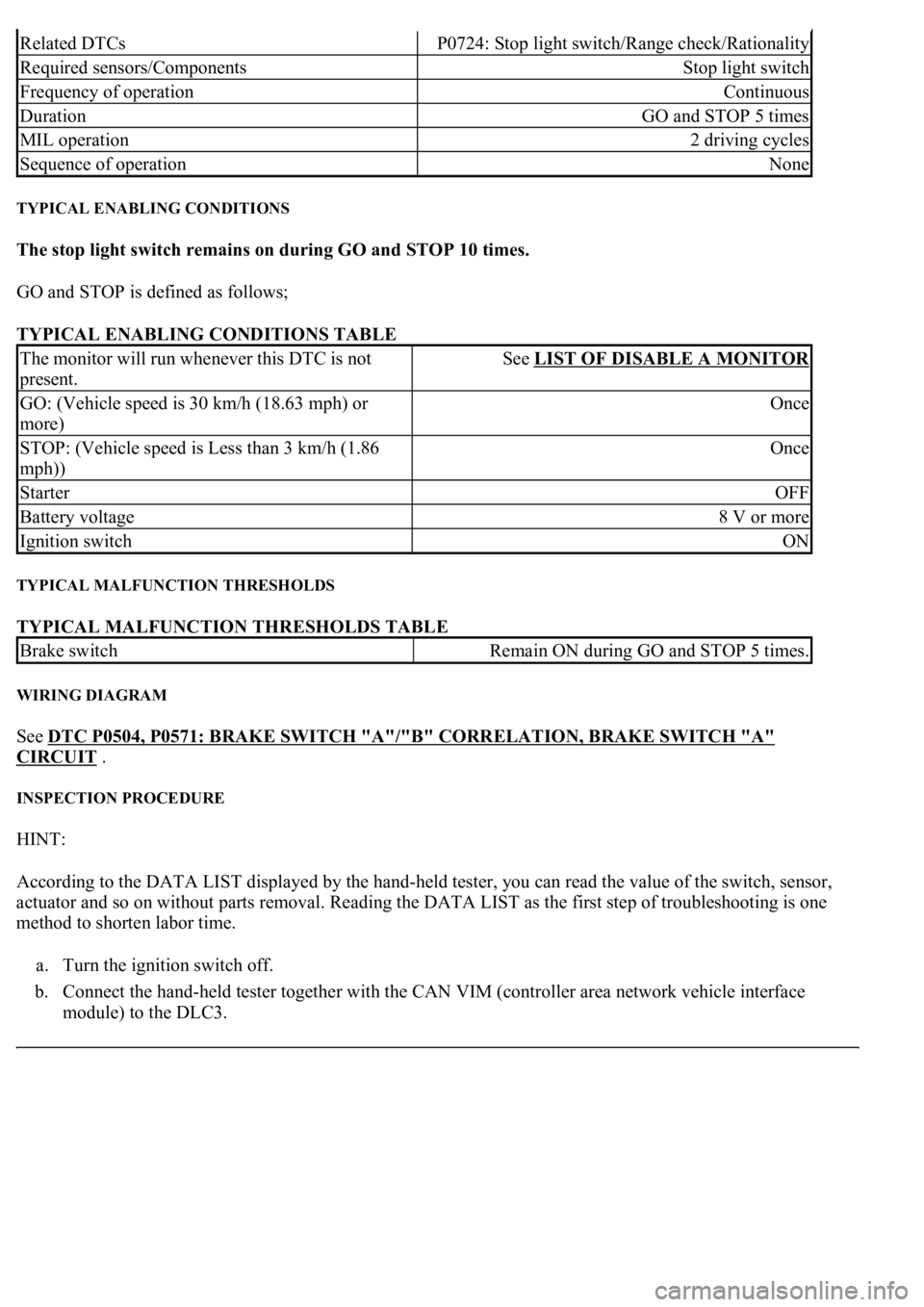
TYPICAL ENABLING CONDITIONS
The stop light switch remains on during GO and STOP 10 times.
GO and STOP is defined as follows;
TYPICAL ENABLING CONDITIONS TABLE
TYPICAL MALFUNCTION THRESHOLDS
TYPICAL MALFUNCTION THRESHOLDS TABLE
WIRING DIAGRAM
See DTC P0504, P0571: BRAKE SWITCH "A"/"B" CORRELATION, BRAKE SWITCH "A"
CIRCUIT .
INSPECTION PROCEDURE
HINT:
According to the DATA LIST displayed by the hand-held tester, you can read the value of the switch, sensor,
actuator and so on without parts removal. Reading the DATA LIST as the first step of troubleshooting is one
method to shorten labor time.
a. Turn the ignition switch off.
b. Connect the hand-held tester together with the CAN VIM (controller area network vehicle interface
module) to the DLC3.
Related DTCsP0724: Stop light switch/Range check/Rationality
Required sensors/ComponentsStop light switch
Frequency of operationContinuous
DurationGO and STOP 5 times
MIL operation2 driving cycles
Sequence of operationNone
The monitor will run whenever this DTC is not
present.See LIST OF DISABLE A MONITOR
GO: (Vehicle speed is 30 km/h (18.63 mph) or
more)Once
STOP: (Vehicle speed is Less than 3 km/h (1.86
mph))Once
StarterOFF
Battery voltage8 V or more
Ignition switchON
Brake switchRemain ON during GO and STOP 5 times.
Page 2761 of 4500
c. Turn the ignition switch to the ON position.
d. Push the "ON" button of the hand-held tester.
e. Select the item "DIAGNOSIS/ENHANCED OBD II/DATA LIST".
f. According to the display on tester, read the "DATA LIST".
Fig. 78: Test Item Reference Chart
Courtesy of TOYOTA MOTOR SALES, U.S.A., INC.
1.INSPECT STOP LAMP SWITCH ASSY
a. Remove the stop lamp switch assy.
b. Measure the resistance according to the value(s) in the table below.
Fig. 79: Inspecting Stop Lamp Switch Assy
Courtesy of TOYOTA MOTOR SALES, U.S.A., INC.
Page 2767 of 4500
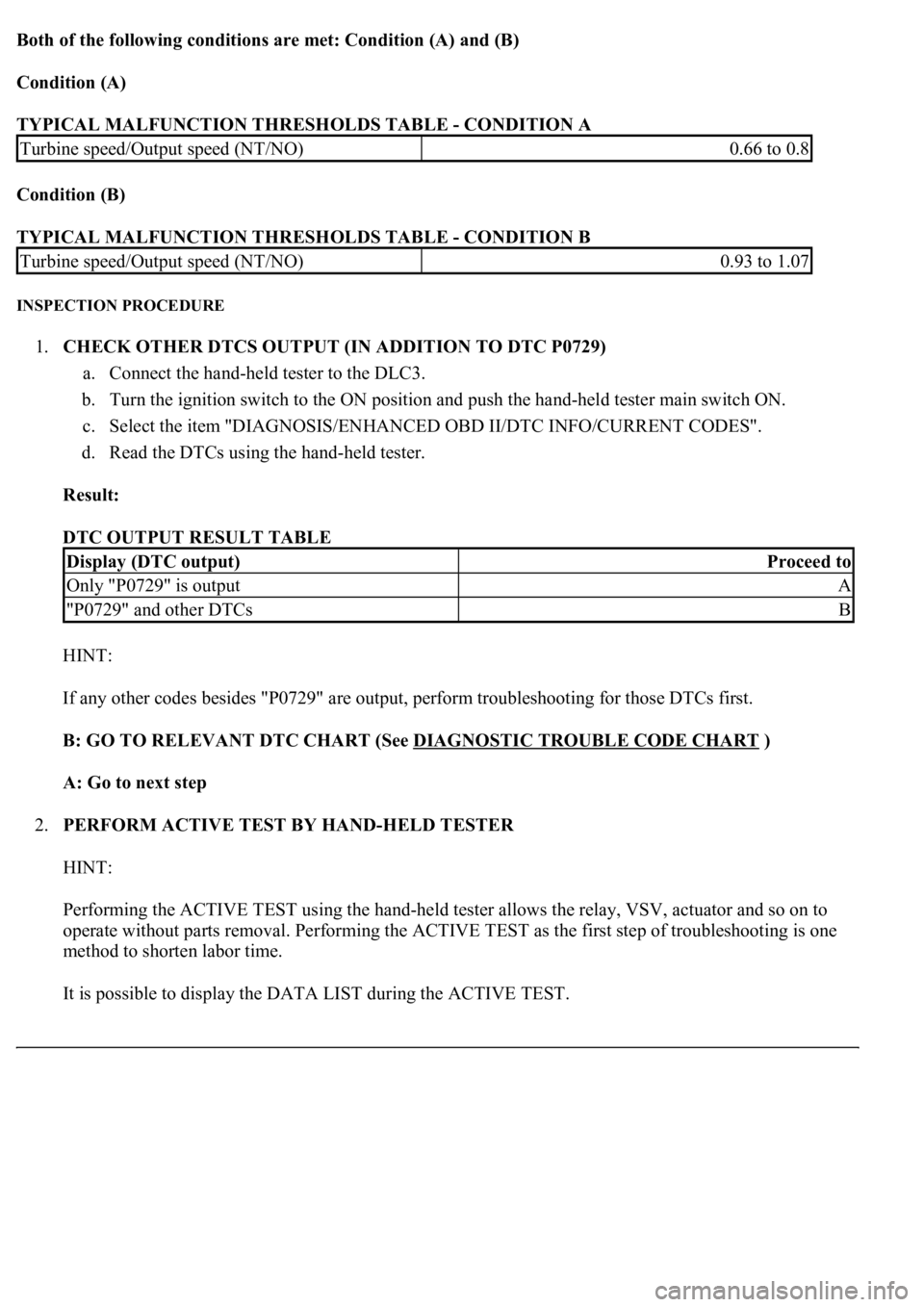
Both of the following conditions are met: Condition (A) and (B)
Condition (A)
TYPICAL MALFUNCTION THRESHOLDS TABLE - CONDITION A
Condition (B)
TYPICAL MALFUNCTION THRESHOLDS TABLE - CONDITION B
INSPECTION PROCEDURE
1.CHECK OTHER DTCS OUTPUT (IN ADDITION TO DTC P0729)
a. Connect the hand-held tester to the DLC3.
b. Turn the ignition switch to the ON position and push the hand-held tester main switch ON.
c. Select the item "DIAGNOSIS/ENHANCED OBD II/DTC INFO/CURRENT CODES".
d. Read the DTCs using the hand-held tester.
Result:
DTC OUTPUT RESULT TABLE
HINT:
If any other codes besides "P0729" are output, perform troubleshooting for those DTCs first.
B: GO TO RELEVANT DTC CHART (See DIAGNOSTIC TROUBLE CODE CHART
)
A: Go to next step
2.PERFORM ACTIVE TEST BY HAND-HELD TESTER
HINT:
Performing the ACTIVE TEST using the hand-held tester allows the relay, VSV, actuator and so on to
operate without parts removal. Performing the ACTIVE TEST as the first step of troubleshooting is one
method to shorten labor time.
It is possible to display the DATA LIST during the ACTIVE TEST.
Turbine speed/Output speed (NT/NO)0.66 to 0.8
Turbine speed/Output speed (NT/NO)0.93 to 1.07
Display (DTC output)Proceed to
Only "P0729" is outputA
"P0729" and other DTCsB
Page 2768 of 4500
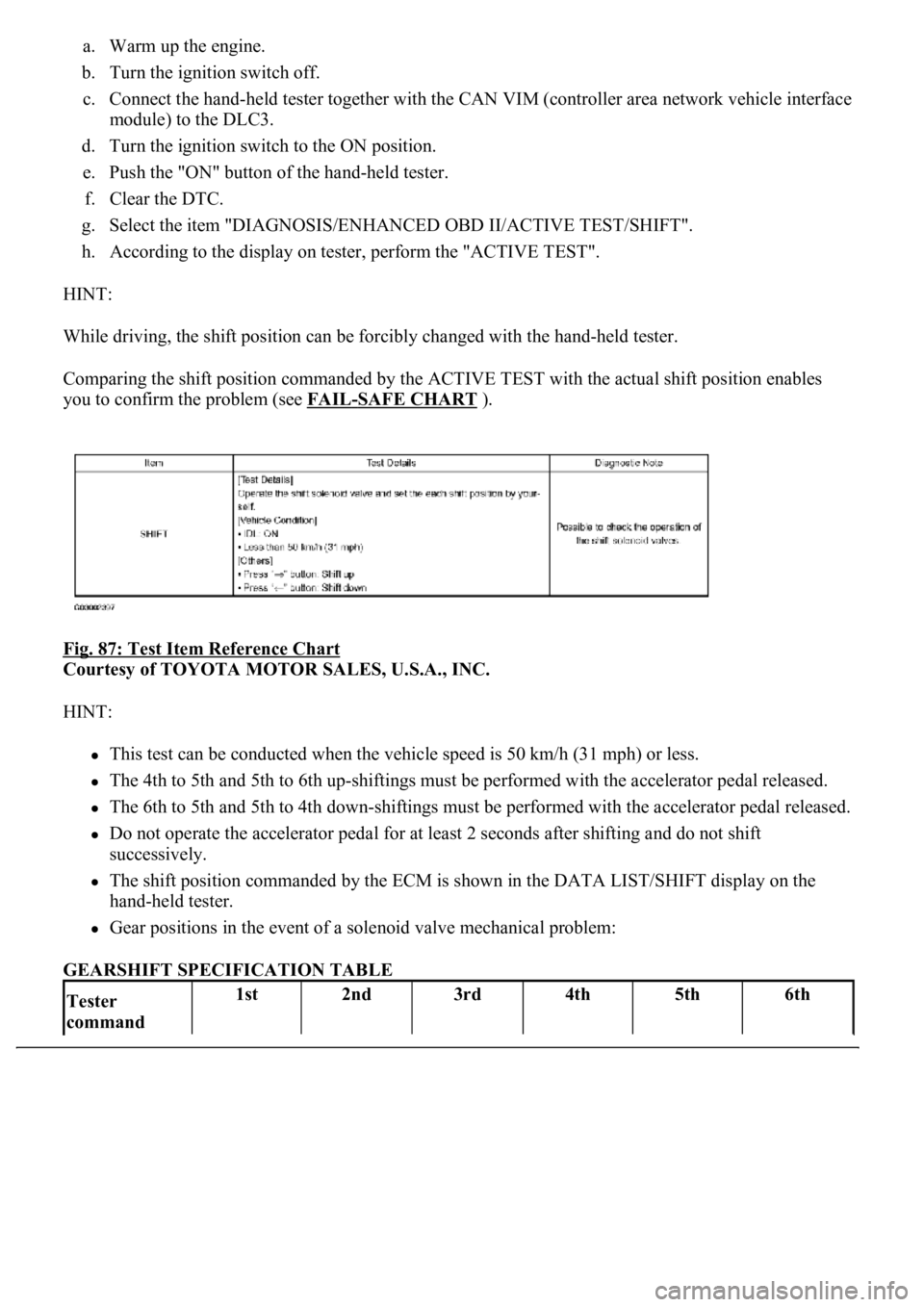
a. Warm up the engine.
b. Turn the ignition switch off.
c. Connect the hand-held tester together with the CAN VIM (controller area network vehicle interface
module) to the DLC3.
d. Turn the ignition switch to the ON position.
e. Push the "ON" button of the hand-held tester.
f. Clear the DTC.
g. Select the item "DIAGNOSIS/ENHANCED OBD II/ACTIVE TEST/SHIFT".
h. According to the display on tester, perform the "ACTIVE TEST".
HINT:
While driving, the shift position can be forcibly changed with the hand-held tester.
Comparing the shift position commanded by the ACTIVE TEST with the actual shift position enables
you to confirm the problem (see FAIL
-SAFE CHART ).
Fig. 87: Test Item Reference Chart
Courtesy of TOYOTA MOTOR SALES, U.S.A., INC.
HINT:
This test can be conducted when the vehicle speed is 50 km/h (31 mph) or less.
The 4th to 5th and 5th to 6th up-shiftings must be performed with the accelerator pedal released.
The 6th to 5th and 5th to 4th down-shiftings must be performed with the accelerator pedal released.
Do not operate the accelerator pedal for at least 2 seconds after shifting and do not shift
successively.
The shift position commanded by the ECM is shown in the DATA LIST/SHIFT display on the
hand-held tester.
Gear positions in the event of a solenoid valve mechanical problem:
GEARSHIFT SPECIFICATION TABLE
Tester
command 1st2nd3rd4th5th6th
Page 2770 of 4500
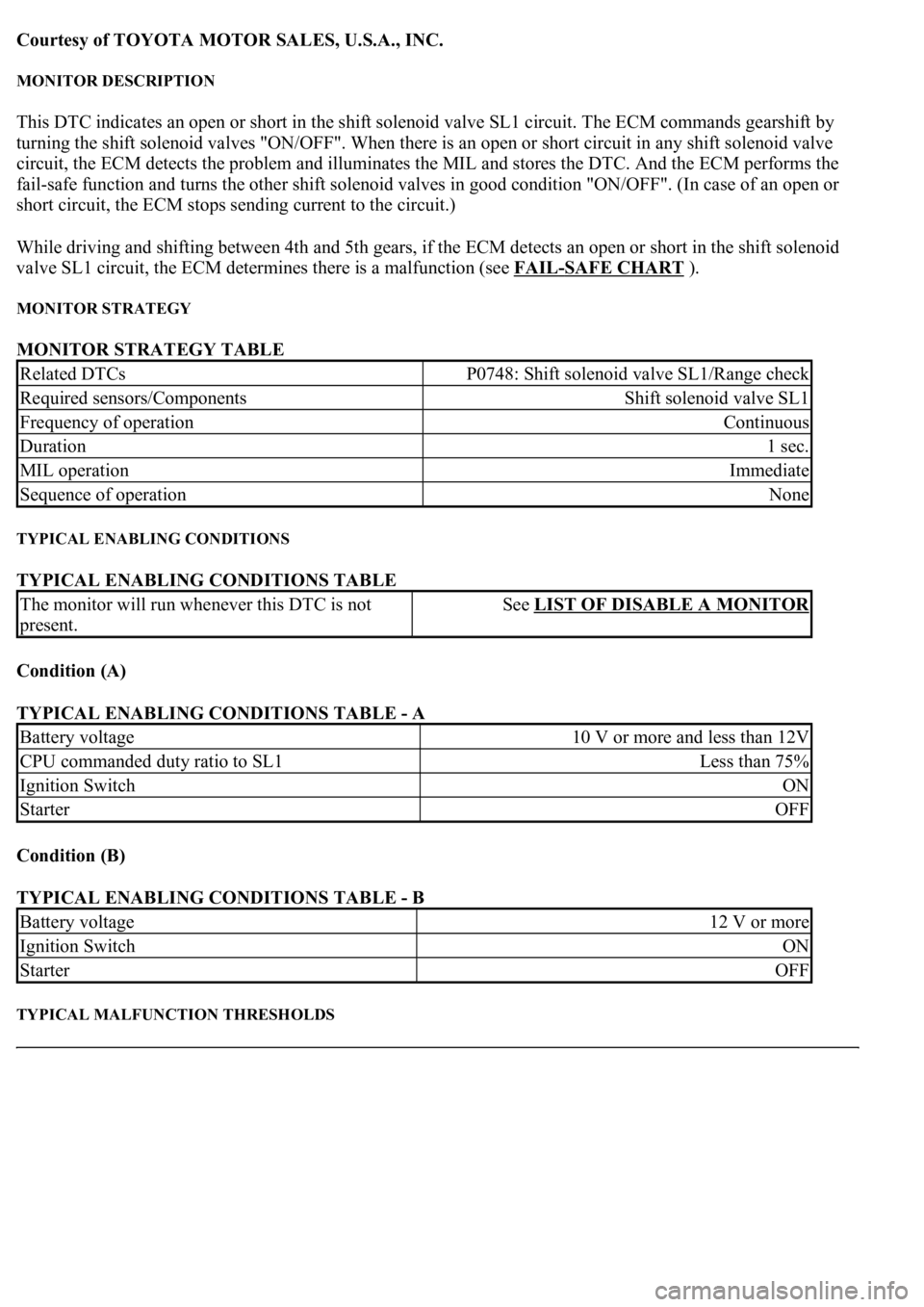
Courtesy of TOYOTA MOTOR SALES, U.S.A., INC.
MONITOR DESCRIPTION
This DTC indicates an open or short in the shift solenoid valve SL1 circuit. The ECM commands gearshift by
turning the shift solenoid valves "ON/OFF". When there is an open or short circuit in any shift solenoid valve
circuit, the ECM detects the problem and illuminates the MIL and stores the DTC. And the ECM performs the
fail-safe function and turns the other shift solenoid valves in good condition "ON/OFF". (In case of an open or
short circuit, the ECM stops sending current to the circuit.)
While driving and shifting between 4th and 5th gears, if the ECM detects an open or short in the shift solenoid
valve SL1 circuit, the ECM determines there is a malfunction (see FAIL
-SAFE CHART ).
MONITOR STRATEGY
MONITOR STRATEGY TABLE
TYPICAL ENABLING CONDITIONS
TYPICAL ENABLING CONDITIONS TABLE
Condition (A)
TYPICAL ENABLING CONDITIONS TABLE - A
Condition (B)
TYPICAL ENABLING CONDITIONS TABLE - B
TYPICAL MALFUNCTION THRESHOLDS
Related DTCsP0748: Shift solenoid valve SL1/Range check
Required sensors/ComponentsShift solenoid valve SL1
Frequency of operationContinuous
Duration1 sec.
MIL operationImmediate
Sequence of operationNone
The monitor will run whenever this DTC is not
present.See LIST OF DISABLE A MONITOR
Battery voltage10 V or more and less than 12V
CPU commanded duty ratio to SL1Less than 75%
Ignition SwitchON
StarterOFF
Battery voltage12 V or more
Ignition SwitchON
StarterOFF
Page 2780 of 4500
![LEXUS LS430 2003 Factory Repair Manual OFF malfunction (C)
TYPICAL MALFUNCTION THRESHOLDS TABLE - OFF MALFUNCTION C
OFF malfunction (D)
TYPICAL MALFUNCTION THRESHOLDS TABLE - OFF MALFUNCTION D
[ON malfunction]
Both of the following LEXUS LS430 2003 Factory Repair Manual OFF malfunction (C)
TYPICAL MALFUNCTION THRESHOLDS TABLE - OFF MALFUNCTION C
OFF malfunction (D)
TYPICAL MALFUNCTION THRESHOLDS TABLE - OFF MALFUNCTION D
[ON malfunction]
Both of the following](/manual-img/36/57050/w960_57050-2779.png)
OFF malfunction (C)
TYPICAL MALFUNCTION THRESHOLDS TABLE - OFF MALFUNCTION C
OFF malfunction (D)
TYPICAL MALFUNCTION THRESHOLDS TABLE - OFF MALFUNCTION D
[ON malfunction]
Both of the following conditions are met: ON malfunction (A) and (B)
2 detections are necessary per driving cycle:
1st detection; temporary flag ON
2nd detection; pending fault code ON
ON malfunction (A)
TYPICAL MALFUNCTION THRESHOLDS TABLE - ON MALFUNCTION A
ON malfunction (B)
TYPICAL MALFUNCTION THRESHOLDS TABLE - ON MALFUNCTION B
INSPECTION PROCEDURE
HINT:
Performing the ACTIVE TEST using the hand-held tester allows the relay, VSV, actuator and so on to operate
without parts removal. Performing the ACTIVE TEST as the first step of troubleshooting is one method to
shorten labor time.
It is possible to display the DATA LIST during the ACTIVE TEST.
a. Warm up the engine.
b. Turn the ignition switch off.
Turbine speed-Output speed x 5th gear ratio (NT-
NO x 5th gear ratio)1,000 rpm or more
Turbine speed-Output speed x 6th gear ratio (NT-
NO x 6th gear ratio)1,000 rpm or more
Turbine speed/Output speed (NT/NO)1.83 or more and 2.27 or less (This means actual
gear is 2nd)
Turbine speed/Output speed (NT/NO)0.66 or more and 0.80 or less (This means actual
gear is 5th)
Page 2781 of 4500
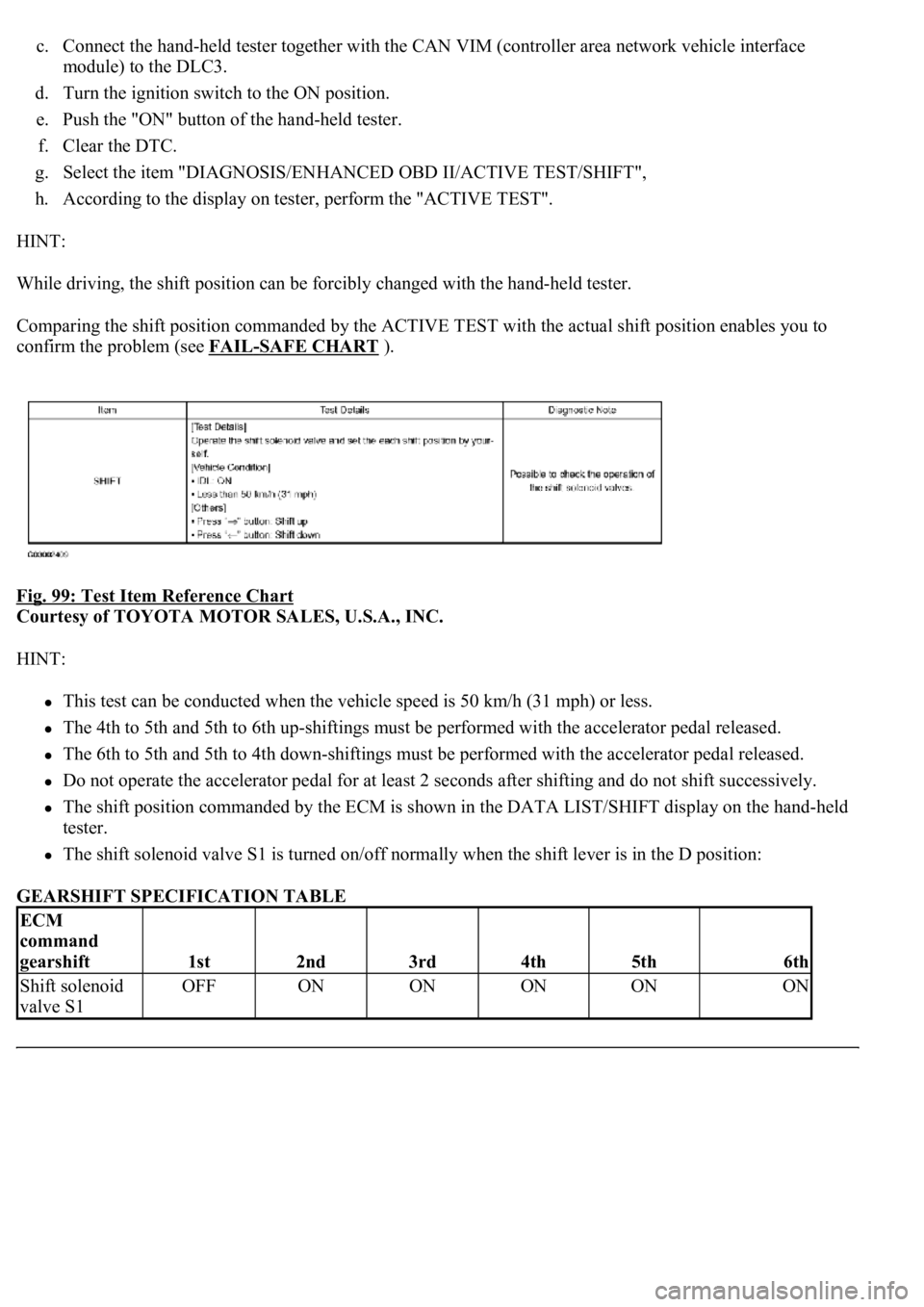
c. Connect the hand-held tester together with the CAN VIM (controller area network vehicle interface
module) to the DLC3.
d. Turn the ignition switch to the ON position.
e. Push the "ON" button of the hand-held tester.
f. Clear the DTC.
g. Select the item "DIAGNOSIS/ENHANCED OBD II/ACTIVE TEST/SHIFT",
h. According to the display on tester, perform the "ACTIVE TEST".
HINT:
While driving, the shift position can be forcibly changed with the hand-held tester.
Comparing the shift position commanded by the ACTIVE TEST with the actual shift position enables you to
confirm the problem (see FAIL
-SAFE CHART ).
Fig. 99: Test Item Reference Chart
Courtesy of TOYOTA MOTOR SALES, U.S.A., INC.
HINT:
This test can be conducted when the vehicle speed is 50 km/h (31 mph) or less.
The 4th to 5th and 5th to 6th up-shiftings must be performed with the accelerator pedal released.
The 6th to 5th and 5th to 4th down-shiftings must be performed with the accelerator pedal released.
Do not operate the accelerator pedal for at least 2 seconds after shifting and do not shift successively.
The shift position commanded by the ECM is shown in the DATA LIST/SHIFT display on the hand-held
tester.
<0037004b004800030056004b004c00490057000300560052004f004800510052004c0047000300590044004f005900480003003600140003004c00560003005700580055005100480047000300520051001200520049004900030051005200550050004400
4f004f005c0003005a004b0048005100030057004b00480003[shift lever is in the D position:
GEARSHIFT SPECIFICATION TABLE
ECM
command
gearshift
1st2nd3rd4th5th6th
Shift solenoid
valve S1OFFONONONONON